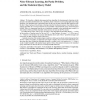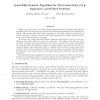562 search results - page 14 / 113 » Simple Randomized Algorithms for Closest Pair Problems |
STOC
2000
ACM
13 years 11 months ago
2000
ACM
We describe a slightly subexponential time algorithm for learning parity functions in the presence of random classification noise, a problem closely related to several cryptograph...
JSS
2007
13 years 7 months ago
2007
Objective: Comparison of program defects caused by programmer pairs and solo developers. Design: Analysis of programs developed during two counter balanced experiments. Setting: P...
ESA
1997
Springer
13 years 11 months ago
1997
Springer
In thispaper we introduce a new class of dynamicgraphalgorithmscalledquasi-fully dynamic algorithms,which are much more general than the backtracking algorithmsand are much simple...
ESA
2004
Springer
14 years 24 days ago
2004
Springer
The size of the Pareto curve for the bicriteria version of the knapsack problem is polynomial on average. This has been shown for various random input distributions. We experimenta...
ACCV
2009
Springer
14 years 2 months ago
2009
Springer
Abstract. In this paper, we propose an efficient method for finding consistent correspondences between two sets of features. Our matching algorithm augments the discriminative pow...


